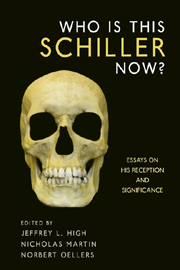Book contents
- Frontmatter
- Contents
- Foreword
- Acknowledgments
- List of Abbreviations
- Introduction: Why Is This Schiller [Still] in the United States?
- Part I Schiller, Drama, and Poetry
- 1 Lenz und Schiller. Die erlebnissymptomatische Dramensprache
- 2 Melancholy in Schiller's Dramas
- 3 Schillers Ästhetik der Trauer. Der Dichter als “elegischer” Lyriker und Dramatiker
- 4 Glühendes Wort zum Ideal über der versagenden Realität — zu Schillers Balladen
- 5 Zwischen Max Piccolomini und Buttler. Wallensteins Orts- und Zeitverluste
- Part II Schiller, Aesthetics, and Philosophy
- Part III Schiller, History, and Politics
- Part IV Schiller Reception — Reception and Schiller
- Part V Schiller Now
- Notes on the Contributors
- Index
1 - Lenz und Schiller. Die erlebnissymptomatische Dramensprache
from Part I - Schiller, Drama, and Poetry
Published online by Cambridge University Press: 05 February 2013
- Frontmatter
- Contents
- Foreword
- Acknowledgments
- List of Abbreviations
- Introduction: Why Is This Schiller [Still] in the United States?
- Part I Schiller, Drama, and Poetry
- 1 Lenz und Schiller. Die erlebnissymptomatische Dramensprache
- 2 Melancholy in Schiller's Dramas
- 3 Schillers Ästhetik der Trauer. Der Dichter als “elegischer” Lyriker und Dramatiker
- 4 Glühendes Wort zum Ideal über der versagenden Realität — zu Schillers Balladen
- 5 Zwischen Max Piccolomini und Buttler. Wallensteins Orts- und Zeitverluste
- Part II Schiller, Aesthetics, and Philosophy
- Part III Schiller, History, and Politics
- Part IV Schiller Reception — Reception and Schiller
- Part V Schiller Now
- Notes on the Contributors
- Index
Summary
New in Lenz's Die Soldaten (The Soldiers, 1776) and Schiller's Kabale und Liebe (Intrigue and Love, 1784) are the proximity to colloquial speech (dialect and sociolect) and the abundant use of stage directions. Significantly, and paradoxically, with the development of book and newspaper printing, it is orality (speech), and not print convention, that makes its mark in literature. Not only language but also physical gestures and manners in stage directions suddenly mirror experience in process and no longer portray a way of thinking that has intellectualized action through (and to) its logical end. Social and media history offer possible explanations for the palpable paradigm shift.
VORAB MEINE THESE: Schillers Soziolekt in Kabale und Liebe wäre ohne die revolutionäre Dramaturgie von Jakob Michael Reinhold Lenz — Mimesis von gesprochener Sprache, Körpersymptomen und Gestik — nicht denkbar gewesen.
Parallel zu Die Soldaten von J. M. R. Lenz erscheint 1776 Die Kindermörderin von Heinrich Leopold Wagner. Eine verunglückende Zweierbeziehung — wie im Urfaust — ist die Basis beider Stücke. Das “Bürgerliche Trauerspiel” zeichnet sich durch eine solche Beziehung aus, meist wird jedoch die Zweierbeziehung durch einen Dritten in zur Katastrophe führender Weise gestört. In Lenzens Soldaten ist Marie Wesener dem Tuchhändler Stolzius versprochen, wird aber vom adeligen Offizier Desportes verführt und dann fallengelassen. Ähnlich wird im Woyzeck Marie, die mit Franz Woyzeck zusammenlebt, durch den Tambourmajor verführt. In Schillers Kabale und Liebe (1784) sympathisiert Luises Vater mit einer Verbindung zwischen seiner Tochter und dem Sekretär Wurm, doch der Luise zwar liebende, aber realitätsfremde Ferdinand von Walter bringt die Katastrophe ins Rollen.
- Type
- Chapter
- Information
- Who Is This Schiller Now?Essays on his Reception and Significance, pp. 25 - 36Publisher: Boydell & BrewerPrint publication year: 2011



